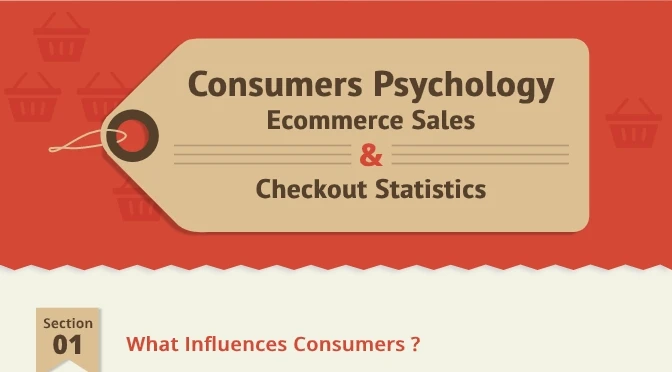Consumers Psychology – Ecommerce Sales & Checkout: Infographic

eCommerce sales worldwide are projected to reach $4.5 trillion in 2021 compared to $1.9 trillion in 2016. eCommerce has become one of the primary channels of revenue for any business. With eCommerce making such strides, it is important for businesses to take note of the growth trends in the industry and adapt itself accordingly. One crucial part of this adaptation is the emphasis you put on your eCommerce website.
When your customers search for their favorite products online, the first interface that they are going to interact with is your website. It is the first impression that consumers get about your business and there and then they decide what image are they going to form in their mind about your business.
Understanding what the customer needs out of your website, is also an important part of the strategy. In this infographic, we explore consumer psychology and decide which factors influence it and by how much.

Embed this infographic on your site
What Influences Consumers?
There are certain things that a customer looks for when they interact with an eCommerce website and as a business owner, it is crucial for you to get those things right.
Did you know that if a website does not load in 2 seconds or less, 47% of the people would drop the website? Or that 84% of people say that online reviews are as trustworthy as recommendations from friends? Or that the 67.91% is the average cart abandonment rate?
All these statistics tell us one thing: If you don’t connect with the customer quickly, they will go someplace else.
Following are the things that affect consumer psychology when they interact with your website:
- Website Design
- Loading Speed
- Product Reviews
- Checkout Experiences
- Payment Options and Security
- Shipping
- Coupons and Deals
1) Website Design
Easy navigation makes it convenient for users to find the information that they are looking for. Helping your customers should be your goal and implementing a great website design is the way to do it.

Customers make buying decisions in a very short span on time. They are juggling with multiple thoughts that help them ultimately decide whether to buy the product or not. In this short time, they are looking for information that will convince them to buy the product that they want. If your website design does not help them find the right information at the right time, they might just drop the idea of buying from your website.
The following statistics show how website design is related to happy customers:
- 48% of people say that a business’s credibility is determined by its website design
- 38% of consumers say that an unattractive layout will make them stop interacting with the website
- 59% of consumers prefer to interact with content that is well designed and attractive
- 74% of users say that if a website is mobile-friendly, they are likely to return to it
- If people have 15 minutes to consume content, 66% of people prefer to look at a beautifully designed website
2) Loading Speed
Even before a customer visits a website, the first thing a customer does is wait. They wait for the website to load. Now, you must have heard about the attention spans of customers growing shorter, the patience levels are too. If the customer waits too long for your website to lead, they are going to switch to some other website.
Website loading speed has a direct correlation with customer retention. The faster your website loads, the more likely customers are to stay on them. Following are a few statistics that show how much the loading speed matters to a customer:
- 2 seconds or less is the time 47% of people expect a web page to load in
- If a website takes more than 3 seconds to load, 40% of consumers prefer to leave the website
- Customer satisfaction reduces by 16% if there is a 60-second delay in loading the website
- 52% of customers say that site loyalty is directly linked to faster loading time
3) Product Reviews
In marketing, nothing works better than word of mouth. Recommendations work like magic because they influence consumer psychology. When a customer writes a review for your product, they, in turn, influence the purchase decisions of many other buyers. The tone of these reviews actually drives your future sales and influence, other customers, to write their reviews.
The statistics below will tell you why you need to focus on getting more positive customer reviews so that other website visitors can also see them:
- 5% – 10% of the reviews written by consumers influence the total e-commerce sales revenue by $400 billion
- Conversions can be increased by 270% using customer reviews
- 94% of consumers get influenced by negative reviews and decide on not visiting a store
- 84% of people say that online reviews are as trustworthy as recommendations from friends
- 75% of people online are influenced positively after reading a positive review of the business
- 68% of consumers are able to make a judgment based on 6 online reviews or less
- 70% of customers said that they will agree to write a review of the product if a business asks them to
4) Checkout Experiences
Everything on your website needs to be streamlined to do one thing and one thing only.
Convert!
Your funnel needs to provide little to no distraction to customers so that they can buy the product that they want. The checkout flow should be streamlined with consumer psychology in such a manner that it helps achieve the required conversion rate for customers while keeping the churn rate down.

Most customers drop out during the final payment in the checkout stage because of a variety of reasons like hidden costs, slow shipping, etc.
The following statistics show which areas you, as a business owner, need to strengthen to improve your chances are customer retention:
- The average cart abandonment rate is 67.91%
- 53% of Online Shoppers say that Unexpected Extra Costs are the primary reasons for abandoning their cart
- The conversion rate can increase by 35.26% by improving checkout design
- Not being ready to buy is the reason that 34% of potential shoppers stated for abandoning their cart
- Slow delivery or poor returns policy has been stated as a reason for abandoning their cart by 27% of consumers
- 10% of shoppers have stated lack of payment methods or a declined credit card as their reason for abandoning their cart
- 24% of shoppers have dropped out of the checkout process because of complicated site navigation
- Successful abandoned cart emails drive 28.3% of all eCommerce revenue
5) Payment Options and Security
Convenience is the name of the game. The more convenient the buying process is for the user, the faster they will convert. One of the sought after conveniences are payment options. Customers rarely prefer to go out of their way and pay using the payment options that they don’t usually use. This can be a problem for you because customers might want to switch to another website that offers them the payment option of their choice.
Another hot topic has been security. Customers prefer to keep their payment information private and not share that.
The statistics below shed light on how the payment options and security affect consumer psychology:
- > 80% of consumers feel safe if they see logos of credit cards that are trustworthy, in an online store
- 40% of consumers say that if an online shop had more than one payment method, they would have more confidence in it
- 59% of customers prefer to drop a transaction if the payment method preferred by them is not in place
- Paypal processes 60% of total web transactions
6) Shipping
Getting the product on time surely has an effect on customer satisfaction. It makes the customer believe that you made good of the promise that you made to the customer, that is, of delivering the product to them on time.
Shipping costs actually do a great job of influencing consumer psychology. Some consumers are willing to pay higher shipping costs to get the product faster while higher shipping costs can make other consumers drop out. And then there are also consumers that want free shipping.
Related: Increase Profit by Ecommerce Shipping
We have researched some statistics that might help you understand as to how much the shipping affects the whole process:
- 24% of shoppers would prefer to spend more to avail the benefits of free shipping
- High shipping costs has been stated by 61% of customers as their reason for abandoning their cart
- 80% of US customers said that they would be more likely to make an online purchase if the shipping was free
- Even for an order under $50, 75% of consumers expect shipping to be free
7) Coupons and Deals
In many regions around the world, consumers are very price sensitive and this price sensitivity is a great influencer. It has led to the rise and the exponential growth of the coupon industry. In 2019, almost 31 billion coupons were redeemed worldwide, digitally. This alone tells you the importance of coupons and deals.
What’s more, is that consumers usually buy more when they have a coupon with them than when they don’t.
- For either online or offline shopping, more than 50% of US adult internet users will redeem a digital coupon through any device
- $91 billion will be the total digital coupon redemptions by 2022
- Customers with coupon codes spend 37% more than customers who don’t have them
- 36% of consumers prefer to buy from somewhere else if there is no coupon available
In conclusion, these 7 factors play a major role in the consumer buying decision and have to be attended to if your website wants to have a reasonable conversion rate.


